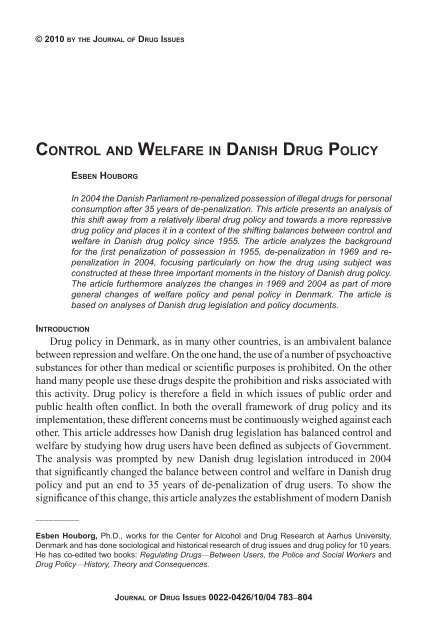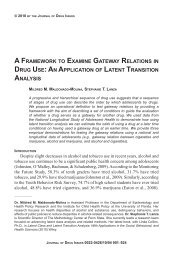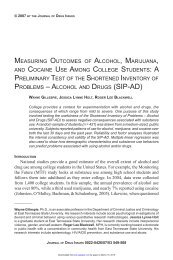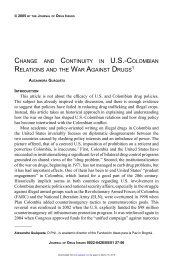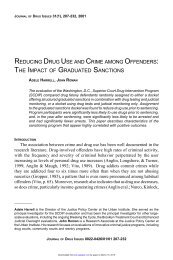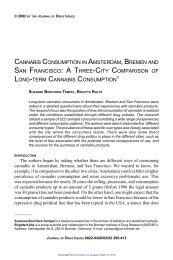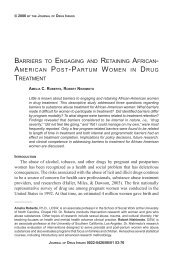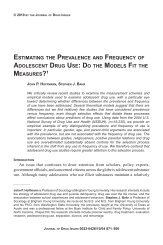control and welfare in danish drug policy - Journal of Drug Issues
control and welfare in danish drug policy - Journal of Drug Issues
control and welfare in danish drug policy - Journal of Drug Issues
You also want an ePaper? Increase the reach of your titles
YUMPU automatically turns print PDFs into web optimized ePapers that Google loves.
HOUBORG<strong>and</strong> other educational <strong>in</strong>stitutions (Manniche & Høgh, 1967, 1968; Manniche & Wolf,1969; Ulff-Møller, 1969; Kontaktudvalget, 1970; Ulff-Møller, 1971; Manniche,Holste<strong>in</strong>, & Boolsen, 1972a; 1972b). The majority <strong>of</strong> this research was based onsociological theories <strong>of</strong> social deviance, specifically theories on social learn<strong>in</strong>g(Becker, 1953; Ulff-Møller & Jørgensen, 1971) <strong>and</strong> theories on the dissem<strong>in</strong>ation<strong>of</strong> <strong>in</strong>novations <strong>in</strong> a population (Holste<strong>in</strong>, 1972). These surveys focused on how <strong>drug</strong>use became a mean<strong>in</strong>gful social activity for young people <strong>and</strong> the social context<strong>in</strong> which this occurred, not simply the immediate social context, but also the moregeneral social <strong>and</strong> cultural contexts. The research therefore focused on trends <strong>in</strong>the number <strong>of</strong> young people who came <strong>in</strong>to contact with illegal <strong>drug</strong>s, how manyprogressed from experiment<strong>in</strong>g with illegal <strong>drug</strong>s to regular use, the social contextfor contact with <strong>and</strong> use <strong>of</strong> <strong>drug</strong>s, <strong>and</strong> last but not least, attitudes toward illegal <strong>drug</strong>samong users <strong>and</strong> non-users. A national survey <strong>in</strong> 1968 showed that one fifth <strong>of</strong> therespondents had been <strong>of</strong>fered <strong>drug</strong>s <strong>and</strong> one <strong>in</strong> ten had tried <strong>drug</strong>s, but only one <strong>in</strong>a hundred was a regular user (Ulff-Møller, 1969; Ulff-Møller & Jørgensen, 1972).When the survey was repeated <strong>in</strong> 1970, four out <strong>of</strong> ten had been <strong>of</strong>fered cannabis<strong>and</strong> one fourth had tried or was us<strong>in</strong>g cannabis. The number <strong>of</strong> regular users hadtherefore risen from 1% <strong>in</strong> 1968 to 4% <strong>in</strong> 1970 (Ulff-Møller, 1971; Ulff-Møller &Jørgensen, 1972). The surveys showed that <strong>drug</strong>s were be<strong>in</strong>g distributed throughnormal social relations <strong>and</strong> not through subcultures, <strong>and</strong> that <strong>drug</strong> use was becom<strong>in</strong>gan <strong>in</strong>creas<strong>in</strong>gly acceptable social activity among young people. In 1968, 56% <strong>of</strong>the respondents <strong>in</strong> the school surveys supported prohibition <strong>of</strong> cannabis, whereas<strong>in</strong> 1970 the figure was only 36% (Ulff-Møller & Jørgensen, 1972). Research aswell as the image constructed by the media therefore revealed that more <strong>and</strong> moreyoung people were com<strong>in</strong>g <strong>in</strong>to contact with illegal <strong>drug</strong>s, that the <strong>drug</strong>s were part<strong>of</strong> their normal social environment <strong>and</strong> that <strong>drug</strong> use was becom<strong>in</strong>g an <strong>in</strong>creas<strong>in</strong>glyacceptable social activity.Generally, one can conclude that the phenomenon development <strong>of</strong><strong>drug</strong> use after the first <strong>of</strong>fer [<strong>of</strong> <strong>drug</strong>s] seems to function <strong>and</strong> couldbe classified as an ord<strong>in</strong>ary, normal social phenomenon <strong>and</strong> notas a socially deviant phenomenon, …. (Ulff-Møller & Jørgensen,1972, p. 88)The use <strong>of</strong> illegal <strong>drug</strong>s was no longer associated with a particular deviant <strong>and</strong>marg<strong>in</strong>alized subculture. It was becom<strong>in</strong>g a normal social phenomenon among youngpeople <strong>in</strong> Denmark. <strong>Drug</strong> use had become a youth phenomenon <strong>and</strong> was associatedwith a dissem<strong>in</strong>ation <strong>of</strong> elements <strong>of</strong> the new youth culture from a small group <strong>in</strong>Copenhagen to the rest <strong>of</strong> the population. In the public debate <strong>and</strong> discussions amongexperts <strong>and</strong> politicians, though less <strong>in</strong> terms <strong>of</strong> research, the social conditions forthe spread <strong>of</strong> <strong>drug</strong> use were also seen as a symptom <strong>of</strong> more general changes <strong>in</strong>788 JOURNAL OF DRUG ISSUES
CONTROL AND WELFARE IN DANISH DRUG POLICY<strong>in</strong>stitutions. This meant that as subjects <strong>of</strong> Government, <strong>drug</strong> users were def<strong>in</strong>ed asnormal social citizens <strong>of</strong> the <strong>welfare</strong> state <strong>and</strong> no longer as deviant crim<strong>in</strong>als. Withreference to the literature on Dutch <strong>drug</strong> <strong>policy</strong> (Leuw, 1991; Grapendaal, & Nelen,1995) one could say that the dem<strong>and</strong> aspect <strong>of</strong> the <strong>drug</strong> problem was “normalized,”as it became a social problem that was no different to other social problems.FROM WELFARE TO CONTROLIn 2000, sensational reports on the widespread use <strong>of</strong> ecstasy among youngpeople, particularly at party venues, <strong>and</strong> reports on deaths attributed to ecstasy,once aga<strong>in</strong> made illegal <strong>drug</strong> use an important public issue. These sensationalistreports were underscored by surveys that revealed a large <strong>in</strong>crease <strong>in</strong> illegal <strong>drug</strong>use generally among young people <strong>in</strong> Denmark dur<strong>in</strong>g the 1990s (Hibell et al.,2000; Sundhedsstyrelsen, 2000). The surveys showed that cannabis was still byfar the most popular <strong>drug</strong>, but also revealed a trend toward the <strong>in</strong>creased use <strong>of</strong>stimulants. The new <strong>drug</strong> problem became part <strong>of</strong> a more general concern aboutthe use <strong>of</strong> <strong>in</strong>toxicat<strong>in</strong>g substances among young people <strong>in</strong> Denmark, as Europeansurveys showed that young people <strong>in</strong> Denmark consumed more alcohol <strong>and</strong> starteddr<strong>in</strong>k<strong>in</strong>g alcohol earlier than young people <strong>in</strong> any other country (Hibell et al., 1997;2000). An image <strong>of</strong> “a new culture <strong>of</strong> <strong>in</strong>toxication” (Measham & Bra<strong>in</strong>, 2005)among young people began to take shape that constituted a new <strong>drug</strong> problem(Balvig, Holmberg, & Sørensen, 2005; Ege, 2003; Gundelach & Järv<strong>in</strong>en, 2006;Østergaard, 2007). In 1999, the National Board <strong>of</strong> Health commissioned a qualitativestudy <strong>of</strong> experiences <strong>and</strong> attitudes toward <strong>drug</strong>s among young people <strong>in</strong> Denmark(Sundhedsstyrelsen, 2000) <strong>and</strong> <strong>in</strong> 2000, the Board conducted a series <strong>of</strong> regionalhear<strong>in</strong>gs to gather <strong>in</strong>formation about changes among young people on the <strong>drug</strong>scene. Both the hear<strong>in</strong>gs <strong>and</strong> the evaluation reported a more liberal attitude towardillegal <strong>drug</strong>s among young people. This more liberal attitude meant that illegal<strong>drug</strong> use was becom<strong>in</strong>g an <strong>in</strong>tegral part <strong>of</strong> the youth culture as such. The hear<strong>in</strong>gs<strong>and</strong> evaluation also reported that illegal <strong>drug</strong> use was particularly associated withthe night-time party scene where dist<strong>in</strong>ctions between legal <strong>and</strong> illegal <strong>drug</strong>s werebeg<strong>in</strong>n<strong>in</strong>g to fade <strong>and</strong> <strong>drug</strong>s were becom<strong>in</strong>g <strong>in</strong>toxicat<strong>in</strong>g consumer goods.Consumption has become more common: Young people do not lookat <strong>drug</strong> use as an isolated phenomenon among socially marg<strong>in</strong>alizedyoung people, nor as a trend that is “only” practiced <strong>in</strong> avant-gardetechno <strong>and</strong> hip-hop environments. Consumption <strong>of</strong> synthetic <strong>drug</strong>shas become modern <strong>and</strong> acceptable by the broad ma<strong>in</strong>stream<strong>of</strong> young people who enjoy a fast-paced youth existence full <strong>of</strong>experiences. [ . . . ] [T]he way young people use illegal <strong>drug</strong>s hascome to resemble the alcohol culture: it is acted out <strong>in</strong> public <strong>in</strong>FALL 2010791
HOUBORGAt the presentation, the M<strong>in</strong>ister <strong>of</strong> Health <strong>and</strong> the M<strong>in</strong>ister <strong>of</strong> Justice described theplan as a <strong>policy</strong> <strong>of</strong> zero tolerance toward what was seen as widespread illegal <strong>drug</strong>use among young people. The M<strong>in</strong>ister <strong>of</strong> Justice stated:The Government wants to send a hard <strong>and</strong> strict signal that we donot tolerate <strong>drug</strong>s. Therefore, young people should not be let <strong>of</strong>fwith a warn<strong>in</strong>g if they are apprehended with even small amounts<strong>of</strong> <strong>drug</strong>s. Instead they will receive an immediate f<strong>in</strong>e. (Politiken20.10.2003)In 2004, the Government presented a bill to re-penalize possession for personalconsumption. The ecstasy report from the Chiefs <strong>of</strong> Police played an important role aspart <strong>of</strong> the background material for the bill. The Government therefore appropriatedthe arguments presented by the Chiefs <strong>of</strong> Police that de-penalization had not workedgiven the high prevalence <strong>of</strong> <strong>drug</strong> use among young people <strong>in</strong> Denmark, particularlywith regard to cannabis.History has shown that this practice [de-penalization] has not beensufficiently effective to restra<strong>in</strong> abuse <strong>of</strong> illegal euphoriant <strong>drug</strong>s.Research shows that young people <strong>in</strong> Denmark abuse cannabis toa larger extent than young people <strong>in</strong> other countries, for example.(The Office <strong>of</strong> the Folket<strong>in</strong>g Hansard, 2003–2004, p. 6313).The Government also agreed with the Chiefs <strong>of</strong> Police that parts <strong>of</strong> the Danishpopulation had a permissive attitude toward the use <strong>of</strong> illegal <strong>drug</strong>s <strong>and</strong> that therewas a need to make the public accept more responsibility. In the parliamentarydebate, the M<strong>in</strong>ister <strong>of</strong> Justice expressed this po<strong>in</strong>t as follows:The Government is serious when it says that the fight aga<strong>in</strong>st <strong>drug</strong>sis to be <strong>in</strong>tensified, <strong>and</strong> that chang<strong>in</strong>g the op<strong>in</strong>ion <strong>in</strong> the populationis necessary, so as citizens we can all become more attentive <strong>and</strong> dowhat we can, particularly to avoid young people becom<strong>in</strong>g part <strong>of</strong>the [<strong>drug</strong>] environment . . . (The Office <strong>of</strong> the Folket<strong>in</strong>g Hansard,2003–2004, p. 7659)Accord<strong>in</strong>g to the Government, de-penalization had removed responsibilityfor <strong>control</strong>l<strong>in</strong>g <strong>drug</strong> use from <strong>in</strong>dividuals <strong>and</strong> families. In this way, the change <strong>in</strong><strong>drug</strong> <strong>policy</strong> came to reflect a more general trend with<strong>in</strong> a number <strong>of</strong> <strong>policy</strong> areas<strong>in</strong> the 1990s <strong>and</strong> 2000s toward what was seen as giv<strong>in</strong>g <strong>in</strong>dividuals, families, <strong>and</strong>communities more responsibility. This has been the case particularly s<strong>in</strong>ce 2001,when the Prime M<strong>in</strong>ister <strong>of</strong> the new liberal 5 -conservative Government declared acultural war on what he saw as cultural relativism <strong>and</strong> a nomenclature <strong>of</strong> expertsdom<strong>in</strong>ated by ideas from the left <strong>of</strong> the political spectrum <strong>and</strong> ideas from the youthculture <strong>of</strong> the 1960s (Lykkeberg, 2008). 6 This trend has been most visible <strong>in</strong> the area<strong>of</strong> penal <strong>policy</strong> partly as penal sanctions have been one <strong>in</strong>strument used to make the794 JOURNAL OF DRUG ISSUES
CONTROL AND WELFARE IN DANISH DRUG POLICYDanes more responsible. With<strong>in</strong> penal <strong>policy</strong>, a number <strong>of</strong> tough-on-crime <strong>in</strong>itiatives<strong>and</strong> new crim<strong>in</strong>alizations were <strong>in</strong>troduced <strong>in</strong> the 1990s <strong>and</strong> 2000s (Balvig, 2004;Nielsen, 2006). In light <strong>of</strong> these changes <strong>in</strong> the political culture <strong>in</strong> Denmark, it ishardly surpris<strong>in</strong>g that possession <strong>of</strong> illegal <strong>drug</strong>s for personal consumption wouldbe re-penalized <strong>in</strong> 2004. The <strong>policy</strong> <strong>of</strong> de-penalization was an obvious example <strong>of</strong> a<strong>welfare</strong> approach to crime <strong>control</strong> from which the new penal <strong>policy</strong> was distanc<strong>in</strong>gitself. The use <strong>of</strong> illegal <strong>drug</strong>s was no longer seen as a symptom <strong>of</strong> more fundamentalsocial <strong>and</strong> cultural factors to be addressed through <strong>welfare</strong> <strong>and</strong> cultural policies, butas an <strong>in</strong>dividual choice by consumers. The fact that consum<strong>in</strong>g illegal <strong>drug</strong>s wasbecom<strong>in</strong>g <strong>in</strong>creas<strong>in</strong>gly common caused partly by a permissive <strong>welfare</strong> <strong>policy</strong> thathad removed responsibility from <strong>in</strong>dividuals <strong>and</strong> families <strong>and</strong> weakened formal <strong>and</strong><strong>in</strong>formal <strong>control</strong> as well as self-restra<strong>in</strong>t. In the parliamentary debate on the newlegislation, it was explicitly described as part <strong>of</strong> the new penal <strong>policy</strong> by members<strong>of</strong> the rul<strong>in</strong>g coalition.Then there is a third po<strong>in</strong>t, which is that now, <strong>and</strong> this is badly needed, as ageneral rule, a f<strong>in</strong>e is issued to those found <strong>in</strong> possession <strong>of</strong> hash or ecstasy or thelike, no matter whether it is half a gram or two grams, <strong>and</strong> no matter whether it is forpersonal consumption or not. The law is the law, <strong>and</strong> the law should be respected.This is the way to build any proper society. It really has been utterly grotesque thatfor many years the legislation has clearly said that it is a crim<strong>in</strong>al <strong>of</strong>fence to smokehash, <strong>and</strong> yet those who use <strong>drug</strong>s have been told: yes, yes, you are not allowedto do it. And next time they do it: yes, yes, you are not allowed to do it. This isreally the same k<strong>in</strong>d <strong>of</strong> laxness we have had toward juvenile del<strong>in</strong>quents for manyyears with charges dropped time after time. (The Office <strong>of</strong> the Folket<strong>in</strong>g Hansard,2003–2004, p. 7651).In 2007, the construction <strong>of</strong> <strong>drug</strong> users as rational <strong>and</strong> self-responsible actorswas underscored when f<strong>in</strong>es for possession <strong>of</strong> illegal <strong>drug</strong>s were raised. In 2004, them<strong>in</strong>imum f<strong>in</strong>e was set at EUR 67 (for possession <strong>of</strong> up to 10 gr. cannabis) whichwas raised to EUR 269 <strong>in</strong> 2007. The M<strong>in</strong>ister <strong>of</strong> Justice claimed that 18, 989 7 casesfor violat<strong>in</strong>g the Law on Euphoriant Substances <strong>in</strong> 2005 showed that a significantnumber <strong>of</strong> young people were still us<strong>in</strong>g illegal <strong>drug</strong>s. The M<strong>in</strong>ister therefore wantedto <strong>in</strong>crease f<strong>in</strong>es to improve the deterrent effect.Illegal possession <strong>of</strong> euphoria-<strong>in</strong>duc<strong>in</strong>g <strong>drug</strong>s must be considered a crim<strong>in</strong>al<strong>of</strong>fence that should have clear <strong>and</strong> noticeable consequences, even if the <strong>drug</strong> isonly for personal consumption. This, <strong>in</strong> the op<strong>in</strong>ion <strong>of</strong> the M<strong>in</strong>istry, is not reflectedsufficiently <strong>in</strong> the exist<strong>in</strong>g level <strong>of</strong> f<strong>in</strong>es. The punishment metered out shouldtherefore clarify that possession <strong>of</strong> illegal <strong>drug</strong>s for personal consumption is notacceptable. A more noticeable sanction will also hopefully contribute toward keep<strong>in</strong>gparticularly young people from us<strong>in</strong>g illegal <strong>drug</strong>s. (Justice Department, 2007, p. 15f)FALL 2010795
HOUBORGThis <strong>policy</strong> was to remove any idea <strong>of</strong> normal, social —or recreational—<strong>drug</strong>use. The conception <strong>of</strong> <strong>drug</strong> use <strong>in</strong> the 1960s as a normal social phenomenon amongyoung people as a consequence <strong>of</strong> societal conditions that should be addressedprimarily through the <strong>welfare</strong> state, disappeared. From that po<strong>in</strong>t, any use <strong>of</strong> illegal<strong>drug</strong>s was by def<strong>in</strong>ition an “abuse” (Matza & Morgan, 1995). The <strong>drug</strong> user wasno longer def<strong>in</strong>ed as a <strong>welfare</strong> subject, but a crim<strong>in</strong>al <strong>of</strong>fender, <strong>and</strong> follow<strong>in</strong>g thetrend <strong>in</strong> penal <strong>policy</strong>—(not just <strong>in</strong> Denmark [Garl<strong>and</strong>, 2001; Simon, 2007])—thecrim<strong>in</strong>al <strong>of</strong>fender was perceived as a rational actor who would either be deterredby punishment or would have to bear the cost <strong>of</strong> <strong>of</strong>fend<strong>in</strong>g. In this way, the costs <strong>of</strong>the <strong>drug</strong> problem were redistributed from the collective to the <strong>in</strong>dividual.There was, however, one important exception to punishment for possession <strong>of</strong>illegal <strong>drug</strong>s. While the majority <strong>of</strong> the population was considered to be amenableto economic <strong>and</strong>/or moral <strong>in</strong>terpellation by the new <strong>drug</strong> <strong>policy</strong>, a small section<strong>of</strong> users were considered unable to act as rational <strong>and</strong> moral actors. This was thecategory <strong>of</strong> people with addiction problems. In 2007, when Parliament raised thelevel <strong>of</strong> f<strong>in</strong>es, this possible exemption <strong>of</strong> economically deprived <strong>drug</strong> addicts waswritten <strong>in</strong>to the letter <strong>of</strong> the law:Warn<strong>in</strong>gs can generally not be issued unless social conditionsmake it relevant to issue a warn<strong>in</strong>g, <strong>and</strong> possession <strong>of</strong> the <strong>drug</strong> is aconsequence <strong>of</strong> strong addiction caused by long-term <strong>and</strong> persistentabuse <strong>of</strong> illegal <strong>drug</strong>s. (Thomas Reuters Pr<strong>of</strong>essional, 2007, p. 1)In this way, a well-known dist<strong>in</strong>ction between <strong>drug</strong> abusers <strong>and</strong> <strong>drug</strong> addictswas written <strong>in</strong>to Danish <strong>drug</strong> legislation (Matza & Morgan, 1995). The dist<strong>in</strong>ctionwas based on whether <strong>in</strong>dividuals were attributed the will <strong>and</strong> the capability to actas law-abid<strong>in</strong>g <strong>and</strong> moral subjects. On the one h<strong>and</strong>, <strong>drug</strong> abusers are consideredto be able, but not will<strong>in</strong>g to act as morally accountable subjects, but <strong>in</strong>stead abusethe community for the benefit <strong>of</strong> satisfy<strong>in</strong>g their egoistic desires. On the other h<strong>and</strong>,<strong>drug</strong> addicts may be will<strong>in</strong>g, but unable to refra<strong>in</strong> from transgress<strong>in</strong>g the legal <strong>and</strong>moral order. The new legislation deleted the space between abuse, addiction <strong>and</strong>normal social use <strong>of</strong> illegal <strong>drug</strong>s created <strong>in</strong> the 1960s, which had def<strong>in</strong>ed <strong>drug</strong>s asa “normal” social problem to be addressed by the <strong>welfare</strong> system. Strik<strong>in</strong>g a balancebetween <strong>control</strong> <strong>and</strong> <strong>welfare</strong> was now left at the discretion <strong>of</strong> the legal system, onthe basis <strong>of</strong> guidel<strong>in</strong>es prepared by the Attorney General (Schmidt, 2008).DANISH DRUG POLICY—STILL AN AMBIVALENT BALANCE BETWEEN REPRESSION AND WELFAREIn the 1950s, a new <strong>drug</strong> problem emerged <strong>in</strong> Denmark, <strong>and</strong> the subsequentchanges <strong>in</strong> Danish <strong>drug</strong> <strong>policy</strong> made a dist<strong>in</strong>ction between <strong>drug</strong> addicts <strong>and</strong> thenew <strong>drug</strong> abusers <strong>in</strong> the vice districts <strong>of</strong> Copenhagen. This new <strong>drug</strong> problem wasperceived as a result <strong>of</strong> anomic conditions dur<strong>in</strong>g <strong>and</strong> immediately after the SecondWorld War. The new abusers <strong>of</strong> illegal <strong>drug</strong>s constituted a limited population <strong>of</strong>796 JOURNAL OF DRUG ISSUES
CONTROL AND WELFARE IN DANISH DRUG POLICYsocially deprived <strong>and</strong> deviant people that was perceived <strong>in</strong> terms <strong>of</strong> social pathology,which was responded to through crim<strong>in</strong>alization, while the ‘old’ medic<strong>in</strong>e addictsrema<strong>in</strong>ed the object <strong>of</strong> medical treatment. In the 1960s, a new <strong>drug</strong> problem onceaga<strong>in</strong> led to a change <strong>in</strong> <strong>drug</strong> <strong>policy</strong>. This time, the spread <strong>of</strong> <strong>drug</strong> use as a normalsocial activity among young people rather than (just) a deviant social activityled to a redef<strong>in</strong>ition <strong>of</strong> illegal <strong>drug</strong> use as a <strong>welfare</strong> problem. <strong>Drug</strong> use was nowconsidered to be one <strong>of</strong> many symptoms <strong>of</strong> general social <strong>and</strong> cultural changeaffect<strong>in</strong>g the entire population. As with many other consequences <strong>of</strong> the societaltransformation, <strong>drug</strong> dem<strong>and</strong> should be addressed through a reformed <strong>welfare</strong> state,which should make the population more resilient aga<strong>in</strong>st various ‘social events’.On the other h<strong>and</strong>, <strong>drug</strong> supply was to be addressed through <strong>in</strong>creased crim<strong>in</strong>alsanctions. In the 2000s, <strong>drug</strong> use once aga<strong>in</strong> appeared to become a normal socialactivity among young people. However, unlike dur<strong>in</strong>g the 1960s, when <strong>drug</strong> dem<strong>and</strong>was constituted as a <strong>welfare</strong> problem, the <strong>drug</strong> <strong>policy</strong> <strong>of</strong> the 2000s constituted it asa crim<strong>in</strong>al problem. As <strong>in</strong> the 1960s, <strong>drug</strong> dem<strong>and</strong> was seen as a consequence <strong>of</strong>social change. Now, though, change was perceived <strong>in</strong> terms <strong>of</strong> the development <strong>of</strong>a consumer society <strong>and</strong> an underm<strong>in</strong><strong>in</strong>g <strong>of</strong> moral responsibility by the <strong>welfare</strong> state<strong>and</strong> its de-penalization <strong>of</strong> illegal possession <strong>of</strong> <strong>drug</strong>s for personal consumption. Inorder to change the behavior <strong>of</strong> the young <strong>drug</strong> consumers <strong>and</strong> re-moralize societyaga<strong>in</strong>st <strong>drug</strong>s, the Government decided to re-penalize possession <strong>of</strong> illegal <strong>drug</strong>sfor personal consumption. Whereas the <strong>drug</strong> <strong>policy</strong> s<strong>in</strong>ce the 1960s differentiatedbetween the supply <strong>and</strong> dem<strong>and</strong> sides <strong>of</strong> the <strong>drug</strong> problem <strong>and</strong> applied differentmeasures to each side, the new <strong>drug</strong> <strong>policy</strong> allows the legal system to determ<strong>in</strong>e <strong>in</strong>each <strong>in</strong>dividual case who should be crim<strong>in</strong>alized <strong>and</strong> who should not.This development should be seen with<strong>in</strong> the context <strong>of</strong> the development <strong>of</strong>Danish <strong>drug</strong> <strong>policy</strong> more generally. Dur<strong>in</strong>g the late 1990s, Danish <strong>drug</strong> treatmentsaw a substantial addition <strong>of</strong> new resources follow<strong>in</strong>g an <strong>in</strong>tense debate that began<strong>in</strong> the early 1990s when the number <strong>of</strong> <strong>drug</strong>-related deaths <strong>in</strong>creased rapidly. Theresult was an almost tripl<strong>in</strong>g <strong>of</strong> persons <strong>in</strong> <strong>drug</strong> treatment <strong>in</strong> Denmark from 1996to 2006 (Sundhedsstyrelsen, 2009). In 2003, an amendment to the Danish sociallegislation obliged the social authorities responsible for provid<strong>in</strong>g <strong>drug</strong> treatmentto <strong>in</strong>itiate treatment with<strong>in</strong> 14 days after a person has requested treatment. This hasimproved the possibilities for <strong>drug</strong> users to realize their social right to treatment.The role to be played by harm reduction has been central to the debate about Danish<strong>drug</strong> <strong>policy</strong> s<strong>in</strong>ce the early 1990s. In 2003, the Government presented an actionplan for Danish <strong>drug</strong> <strong>policy</strong> that stated its adherence to the central position thatharm reduction has had <strong>in</strong> Danish <strong>drug</strong> <strong>policy</strong> s<strong>in</strong>ce the mid-1980s with easy accessto clean syr<strong>in</strong>ges <strong>and</strong> relatively low threshold methadone treatment (Reger<strong>in</strong>gen,2003). Yet, it also stated that harm reduction should always be subord<strong>in</strong>ated to whatFALL 2010797
HOUBORGit referred to as, “the fundamental prohibition aga<strong>in</strong>st all non-medical use <strong>of</strong> illegal<strong>drug</strong>s.” This meant that some harm reduction measures such as safe <strong>in</strong>jection roomscould not be accepted, as they would underm<strong>in</strong>e this prohibition. In 2007, however,the Government was forced to accept the <strong>in</strong>troduction <strong>of</strong> substitution treatment withhero<strong>in</strong> for a relatively small number <strong>of</strong> <strong>drug</strong> users.In a European context, the legislative changes br<strong>in</strong>g Danish <strong>drug</strong> <strong>policy</strong> closerto the ma<strong>in</strong>stream <strong>of</strong> <strong>drug</strong> policies <strong>of</strong> the member states <strong>of</strong> the European Union <strong>and</strong>away from the m<strong>in</strong>ority <strong>of</strong> countries that have more liberal <strong>drug</strong> policies, such as theNetherl<strong>and</strong>s, Germany, <strong>and</strong> Portugal (European Monitor<strong>in</strong>g Centre for <strong>Drug</strong>s <strong>and</strong><strong>Drug</strong> Addiction [EMCDDA], 2005). Whereas other countries seem to be mov<strong>in</strong>gtoward less punitive <strong>drug</strong> policies by mak<strong>in</strong>g sanctions less severe <strong>and</strong> putt<strong>in</strong>gmore emphasis on <strong>welfare</strong> <strong>and</strong> treatment, Denmark has moved toward a morepunitive <strong>drug</strong> <strong>policy</strong> while prioritiz<strong>in</strong>g treatment. In this way, Danish <strong>drug</strong> <strong>policy</strong>has come to resemble the <strong>drug</strong> <strong>policy</strong> <strong>of</strong> the majority <strong>of</strong> European countries, whichemphasizes that the use <strong>and</strong> possession <strong>of</strong> illegal <strong>drug</strong>s should rema<strong>in</strong> illegal <strong>and</strong>subject to sanctions, while allow<strong>in</strong>g more scope for <strong>welfare</strong> <strong>and</strong> treatment <strong>in</strong> theState’s response to illegal <strong>drug</strong>s. While <strong>drug</strong> use <strong>in</strong> many countries for many yearshas been responded to as a crime, this was not the dom<strong>in</strong>ant approach <strong>in</strong> Denmarkfor 35 years.As <strong>in</strong> the 1950s, Danish <strong>drug</strong> <strong>policy</strong> <strong>in</strong> the 2000s once aga<strong>in</strong> operates with twocategories <strong>of</strong> <strong>drug</strong> users: <strong>drug</strong> abusers who willfully break the law, <strong>and</strong> <strong>drug</strong> addictswho may not willfully break the law. The middle ground between abuse <strong>and</strong> addiction<strong>of</strong> normal social use <strong>of</strong> illegal <strong>drug</strong>s has disappeared. The new <strong>drug</strong> <strong>policy</strong> has,to a larger extent, redistributed the costs <strong>of</strong> the <strong>drug</strong> problem from society to the<strong>in</strong>dividual, <strong>and</strong> tipped the balance <strong>of</strong> <strong>control</strong> <strong>and</strong> <strong>welfare</strong> toward a clearer emphasison <strong>control</strong>. In this way, today, <strong>drug</strong> use <strong>in</strong> Denmark is more than before ‘governedthrough crime’ (2007), rather than through <strong>welfare</strong>.NOTES1. By 1953, 300 persons had been registered (Home Office, 1953, p. 66)2. In this way, the development <strong>of</strong> the Danish <strong>drug</strong> problem resembles thedevelopment <strong>of</strong> the <strong>drug</strong> problem <strong>in</strong> other countries (Glanz, 1994; Mold,2004;Stimson & Oppenheimer, 1982).3. This was partly a response to the rapid development <strong>of</strong> the new <strong>drug</strong> problem,<strong>and</strong> partly <strong>in</strong> order to align Danish legislation with the <strong>drug</strong> legislation <strong>in</strong>other Nordic countries (Folket<strong>in</strong>gstidende, 1968, appendix A, 2846). The newlegislation was made by add<strong>in</strong>g a new section on aggravated violations <strong>of</strong> the<strong>drug</strong> legislation to the penal code (Section 191).4. The idea <strong>of</strong> normalization has become a govern<strong>in</strong>g image <strong>in</strong> Danish <strong>drug</strong> <strong>policy</strong>.In 2004, a White Paper on the future organization <strong>of</strong> the police <strong>in</strong> Denmark798 JOURNAL OF DRUG ISSUES
CONTROL AND WELFARE IN DANISH DRUG POLICYconta<strong>in</strong>ed the follow<strong>in</strong>g paragraphs about the normalization <strong>of</strong> <strong>drug</strong> use amongyoung people:In the field <strong>of</strong> <strong>drug</strong>s <strong>in</strong> recent years, a trend toward ‘normalization’has been revealed <strong>in</strong> which large groups <strong>of</strong> young people practice“recreational use” <strong>of</strong> e.g. ecstasy, speed <strong>and</strong> coca<strong>in</strong>e at weekends.This trend is visible all over the country —also among so-calledsocially <strong>in</strong>tegrated young people. (Justitsm<strong>in</strong>isteriet, 2005, p. 15)5. Liberal is not used <strong>in</strong> the American sense <strong>of</strong> the word.6. The tendency toward more <strong>control</strong> <strong>and</strong> punishment <strong>and</strong> less <strong>welfare</strong> <strong>in</strong> penal<strong>policy</strong> began under the former Government led by the Social Democrats, <strong>and</strong>it should be mentioned that the Social Democrats also supported the new <strong>drug</strong>legislation.7. The number <strong>of</strong> cases had risen from 9549 <strong>in</strong> 2004. Naturally, this near doubl<strong>in</strong>g<strong>of</strong> the number <strong>of</strong> cases was attributed to the new zero-tolerance <strong>policy</strong>.REFERENCESAndersen, B. R.1971 Den nye socialreform. In O. Gade-Lorentzen, Henn<strong>in</strong>gensen, K., & Kruse,A-M. (Eds.), Socialpolitik, socialmedic<strong>in</strong>, socialpædagogik. København:Hans Reitzels forlag.Andersen, H.1965 Euforiserende st<strong>of</strong>fer. Politiet, Februar.Andersen, H.1970 St<strong>of</strong>brugere i de københavnske fængsler 1/7-1965 - 1/7-1969. København:Vestre Hospital og Sociologisk Institut, Københavns Universitet.Asmussen, V., & Jepsen, J.2007 Dansk narkotika-kontrolpolitik—aktuelt og historisk. In J. Sejer Pedersen(Ed.), Ret og Samfund 2007. København: Frydenlund.Balvig, F.2004 When law <strong>and</strong> order returned to Denmark. <strong>Journal</strong> <strong>of</strong> Sc<strong>and</strong><strong>in</strong>avian Studies<strong>in</strong> Crim<strong>in</strong>ology <strong>and</strong> Crime Prevention, 5, 167–187.Balvig, F., Holmberg, L., & Sørensen, A.-S.2005 R<strong>in</strong>gstedforsøget. Livsstil og forebyggelse i lokalsamfundet. København:Jurist- og Økonomforbundets Forlag.Becker, H. S.1953 Becom<strong>in</strong>g a marihuana user. The American <strong>Journal</strong> <strong>of</strong> Sociology, 59(3),235–242.Benoit, E.2003 Not just a matter <strong>of</strong> crim<strong>in</strong>al justice: States, <strong>in</strong>stitutions, <strong>and</strong> NorthAmerican <strong>drug</strong> <strong>policy</strong>. Sociological Forum, 18(2), 269–294.FALL 2010799
HOUBORGBrydensholt1972 Narcotics <strong>and</strong> Punishment. [Narkotika og straf] Copenhagen:Juristforbundets Forlag.Cohen, P.1997 Crack <strong>in</strong> the Netherl<strong>and</strong>s. Effective social <strong>policy</strong> is effective <strong>drug</strong> <strong>policy</strong>.In C. Re<strong>in</strong>arman & H. G. Lev<strong>in</strong>e (Eds), Crack <strong>in</strong> America. Demon <strong>Drug</strong>s<strong>and</strong> Social Justice. Berkeley: University <strong>of</strong> California Press, 214–224.Ege, P.2003 Hvorfor stiger unges forbrug af st<strong>of</strong>fer? Psykiatri <strong>in</strong>formation, 10(4), 12–14.Ellermann, M., & Jersild, J.1953 Bilag 2. Praktiske erfar<strong>in</strong>ger vedrørende eufomanien i Storkøbenhavn.In Indenrigsm<strong>in</strong>isteret (Ed.), Betænkn<strong>in</strong>g om misbrug af euforiserendest<strong>of</strong>fer. København.European Monitor<strong>in</strong>g Centre for <strong>Drug</strong>s <strong>and</strong> <strong>Drug</strong> Addiction (EMCDDA)2005 Illicit <strong>Drug</strong> Use <strong>in</strong> the EU: Legislative Approaches. Lisbon: EuropeanMonitor<strong>in</strong>g Centre for <strong>Drug</strong>s <strong>and</strong> <strong>Drug</strong> Addiction.Garl<strong>and</strong>, D.2001 The culture <strong>of</strong> <strong>control</strong>: Crime <strong>and</strong> social order <strong>in</strong> contemporary society.Oxford: Claradon.Glanz, A.1994 The fall <strong>and</strong> rise <strong>of</strong> the general practitioner. In J. Strang & M. Gossop(Eds.), Hero<strong>in</strong> Addiction <strong>and</strong> <strong>Drug</strong> Policy. The British System. Oxford:Oxford University Press, 151–166.Grapendaal, M. L. E., & Nelen, H.1995 A world <strong>of</strong> opportunities. Lifestyle <strong>and</strong> economic behavior <strong>of</strong> hero<strong>in</strong>addicts <strong>in</strong> Amsterdam. Albany: State University <strong>of</strong> New York Press.Gundelach, P., & Järv<strong>in</strong>en, M.2006 De danske europarekord<strong>in</strong>dehavere. In P. Gundelach & M. Järv<strong>in</strong>en (Eds.),Unge, fester og alkohol. København: Akademisk Forlag, 11–26.Haastrup, S.1970 Hospitals<strong>in</strong>dlagte unge med medic<strong>in</strong>misbrug. Ugeskrift for læger, 132(28),1327–1331.Hibell, B., Andersson, B., Bjarnason, T., Kokkevi, A., Morgan, M., & Narusk, A.1997 The 1995 ESPAD Report. Stokholm: The European School Survey Projecton Alcohol <strong>and</strong> Other <strong>Drug</strong>s.Hibell, B., Andersson, B., Bjarnason, T., Kokkevi, A., Morgan, M., & Narusk, A.2000 The 1999 Espad Report. Stokholm: The European School Survey Projecton Alcohol <strong>and</strong> Other <strong>Drug</strong>s.800 JOURNAL OF DRUG ISSUES
CONTROL AND WELFARE IN DANISH DRUG POLICYHolste<strong>in</strong>, B. E.1972 Spredn<strong>in</strong>g af st<strong>of</strong>fer. In J. W<strong>in</strong>sløw (Ed.), Ungdom og st<strong>of</strong>brug. København:Jørgen Paludans Forlag.Houborg, E.2006 St<strong>of</strong>misbrug, metadon, subjektiver<strong>in</strong>g. Historiske og aktuelle fremstill<strong>in</strong>geraf st<strong>of</strong>misbrug. København: Sociologisk Institut.Houborg, E.2008 Youth, <strong>drug</strong>s <strong>and</strong> the <strong>welfare</strong> state. In V. Asmussen, B. Bagga & E. Houborg(Eds.), <strong>Drug</strong> Policy. History, Theory <strong>and</strong> Consequences. Aarhus: AarhusUniversity Press.Jepsen, J.1966 Marihuana i krim<strong>in</strong>ologisk og juridisk belysn<strong>in</strong>g. In E. Thygesen (Ed.), Ermarihuana skadelig? (169–248). København: Stig Vendelkærs Forlag.Jepsen, J.1967 Efterskrift. In P. Laurie (Ed.), Fakta om narkotika.. København: ChristianEjlers’ Forlag, 174–188.Jepsen, J.1969 St<strong>of</strong>misbrug og social isolation. Mentalhygiejne(1), 8–12.Justitsm<strong>in</strong>isteriet2005 Fremtidens politi.Kontaktudvalget1969 Redegørelse for omfanget af en række akutte foranstaltn<strong>in</strong>ger modungdomsnarkomanien. København: Alkohol- og narkotikarådet.Kontaktudvalget1970 Redegørelse II om visse sider af st<strong>of</strong>misbrugsproblemets udvikl<strong>in</strong>g ogforslag til påtrængende foranstaltn<strong>in</strong>ger. København: Kontaktudvalgetvdr ungdomsnarkomanien.Kontaktudvalget1972 Redegørelse III om prævention af st<strong>of</strong>misbrug. København:Kontaktudvalget vedørende ungdomsnarkomanien.Leuw, E.1991 <strong>Drug</strong>s <strong>and</strong> <strong>drug</strong> <strong>policy</strong> <strong>in</strong> the Netherl<strong>and</strong>s. Crime <strong>and</strong> Justice, 14,229–276.Lorentsen, H.2001 F<strong>in</strong>es for young <strong>drug</strong> abusers. [Bøder til unge misbrugere]. July 11. BT,p.15.Lykkeberg, R.2008 Kampen om s<strong>and</strong>hederne—om det kulturelle borgerskabs storhed og fald.København: Gyldendal.FALL 2010801
HOUBORGMacGregor, S.1999a <strong>Drug</strong> treatment systems <strong>and</strong> <strong>policy</strong> frameworks: A comparative social<strong>policy</strong> perspective. European Addiction Research(5), 118–125.MacGregor, S.1999b Medic<strong>in</strong>e, custom or moral fibre: Policy responses to <strong>drug</strong> misuse. In N.South (Ed.), <strong>Drug</strong>s. Cultures, Controls <strong>and</strong> Everyday Life. London: Sage.Manniche, E., & Høgh, E.1967 Hashbrug bl<strong>and</strong>t dansk storbyungdom. Sociologiske meddelelser(12),61–66.Manniche, E., & Høgh, E.1968 Unge mænd og kv<strong>in</strong>ders holdn<strong>in</strong>ger m.h.t. hash. Tidsskrift forsygeplejersker, 68, 383–385.Manniche, E., Holste<strong>in</strong>, B. E., & Boolsen, M. W.1972a St<strong>of</strong>brug bl<strong>and</strong>t skoleungdom i Roskilde 1972. København: Kontaktudvalgetvedrørende ungdomsnarkomanien.Manniche, E., Holste<strong>in</strong>, B. E., & Boolsen, M. W.1972b En empirisk og teoretisk analyse af st<strong>of</strong>brug bl<strong>and</strong>t unge på Bornholm1972. København: Kontaktudvalget vedrørende ungdomsnarkomanien.Manniche, E., & Wolf, P.1969 Hash og narkotika. Mentalhygiejne(1).Matza, D., & Morgan, P.1995 Controll<strong>in</strong>g <strong>drug</strong> use: The great prohibition. In T. G. Blomberg & S. Cohen(Eds.), Punishment <strong>and</strong> Social Control. Essays <strong>in</strong> Honor <strong>of</strong> Sheldon L.Mess<strong>in</strong>ger. New York: Ald<strong>in</strong>e de Gruyter, 229–241.Measham, F., Aldrige, J., & Parker, H.2001 Danc<strong>in</strong>g on <strong>drug</strong>s: Risk, health <strong>and</strong> hedonism <strong>in</strong> the British club scene.London: Free Association Books.Measham, F., & Bra<strong>in</strong>, K.2005 ‘B<strong>in</strong>ge’ dr<strong>in</strong>k<strong>in</strong>g, British alcohol <strong>policy</strong> <strong>and</strong> the new culture <strong>of</strong> <strong>in</strong>toxication.Crime, Media, Culture, 1(3), 262–283.Mold, A.2004 The ‘British System’ <strong>of</strong> hero<strong>in</strong> addiction treatment <strong>and</strong> the open<strong>in</strong>g <strong>of</strong> <strong>drug</strong>dependence units, 1965–1970. Social History <strong>of</strong> Medic<strong>in</strong>e, 17(3),501–517.Nielsen, B. G.2006 Straf. Hvad ellers? København: Tiderne Skifter.Nimb, M.1961 Narkotika, sovemidler og stimulanser. København: Berl<strong>in</strong>gske Forlag.802 JOURNAL OF DRUG ISSUES
CONTROL AND WELFARE IN DANISH DRUG POLICYNimb, M.1972 Misbrug af euforiserende st<strong>of</strong>fer i Danmark i 1950erne medefterundersøgelse i 1972. København: Københavns Universitet.O’Malley, P., & Mugford, S.1991 The dem<strong>and</strong> for <strong>in</strong>toxicat<strong>in</strong>g commodities. Implications for the war on<strong>drug</strong>s. Social Justice, 18(4), 49–75.Østergaard2007 Youth b<strong>in</strong>ge dr<strong>in</strong>k<strong>in</strong>g <strong>and</strong> the parents paradox. Copenhagen: Department <strong>of</strong>Sociology, University <strong>of</strong> Copenhagen.Reger<strong>in</strong>gen2003 Kampen mod narko - h<strong>and</strong>l<strong>in</strong>gsplan mod narkotikamisbrug. København:Indenrigs- og Sundhedsm<strong>in</strong>isteriet.Rold Andersen, B.1971 Grundpr<strong>in</strong>cipper i socialpolitikken. Albertslund: Nyt socialt bibliotek. Detdanske forlag.Schmidt, H.2008 Sanktionspåst<strong>and</strong>e mv. i narkotikasager.Simon, J.2007 Govern<strong>in</strong>g through crime. How the war on crime transformed Americ<strong>and</strong>emocracy <strong>and</strong> created a culture <strong>of</strong> fear. Oxford: Oxford University Press.Smart, C.1984 Social <strong>policy</strong> <strong>and</strong> <strong>drug</strong> addiction: A critical study <strong>of</strong> <strong>policy</strong> development.British <strong>Journal</strong> <strong>of</strong> Addiction, 79, 31–39.Stimson, G. V., & Oppenheimer, E.1982 Hero<strong>in</strong> addiction. Treatment <strong>and</strong> <strong>control</strong> <strong>in</strong> Brita<strong>in</strong>. London: TavistockPublications.Sundhedsstyrelsen2000 Unges brug af illegale rusmidler - en kvalitativ undersøgelse. København:Sundhedsstyrelsen.Sundhedsstyrelsen2009 Narkotikasituationen I Danmark. København: Sundhedsstyrelsen.The Home Office1953 White paper on abuse <strong>of</strong> euphoriant substances. [Betænkn<strong>in</strong>g ommisbrug af euforiserende st<strong>of</strong>fer] Copenhagen.The Office <strong>of</strong> the Folket<strong>in</strong>g Hansard1968 The Danish parliment <strong>in</strong>The Union <strong>of</strong> Police Chiefs2002 Ecstasy-rapport. The Union <strong>of</strong> Police Chiefs.FALL 2010803
HOUBORGThomas Reuters Pr<strong>of</strong>essional2007 Law 2007-06-06 no. 526 on changes <strong>of</strong> the Act <strong>of</strong> Euphoriant Substances[Lov 2007-06-06 nr. 526 om ændr<strong>in</strong>g af lov om euforiserende st<strong>of</strong>fer].Copenhagen: Thomas Reuters Pr<strong>of</strong>essional.Turner, B. S.1993 Contemporary problems <strong>in</strong> the theory <strong>of</strong> cItizenship. In B. S. Turner (Ed.),Citizenship <strong>and</strong> Social Theory. London: Sage Publishers, 1–18.Ulff-Møller, B.1969 Forbruget af euforiserende st<strong>of</strong>fer bl<strong>and</strong>t unge i foråret 1968. SocialtTidsskrift, 45, 87–112.Ulff-Møller, B.1971 Udbredelse af st<strong>of</strong>brug bl<strong>and</strong>t danske skoleelever. København:Kontaktudvalget vedrørende ungdomsnarkomanien.Ulff-Møller, B., & Jørgensen, F.1971 Nogle resultater fra census-undersøgelser af st<strong>of</strong>misbrugere på sygehuse,på børne- og ungdomsforsorgens <strong>in</strong>stitutioner, i fængsler og <strong>in</strong>denforDansk Forsorgsselskab. Socialt Tidsskrift(1–2).Ulff-Møller, B., & Jørgensen, F.1971 To modeller for udvikl<strong>in</strong>g af stobrug bl<strong>and</strong>t skoleelever i Danmark. SocialtTidsskrift, 47(1–2), 427–438.Ulff-Møller, B., & Jørgensen, F.1972 Spredn<strong>in</strong>g af st<strong>of</strong>brug bl<strong>and</strong>t danske skoleelever fra 1968 til 1970. In J.W<strong>in</strong>sløw (Ed.), Ungdom og St<strong>of</strong>brug. København: Jørgen Paludans Forlag.Vennekilde, L.V.2003 <strong>Drug</strong> <strong>policy</strong> has become an ideological battleground. [Narkopolitik erblevet ideologisk kampplads]. Politiken, November 24. p. 4.Villadsen, K.2003 Det sociale arbejdes genealogi. Københavns Universitet, København.Voss, T., & Ziirsen, M.1971 St<strong>of</strong>misbrug—en samfundssygdom. København: Thann<strong>in</strong>g & AppelsForlag.W<strong>in</strong>sløw, J. H.1991 Videnskabelig hverdag. En sociologisk undersøgelse af forholdet mellempraksis og selvforståelse i empiriske videnskaber. Holte: ForlagetSOCPOL.Østergaard2007 Youth, b<strong>in</strong>ge dr<strong>in</strong>k<strong>in</strong>g <strong>and</strong> the parents’ paradox. Unpublished PhD thesis,University <strong>of</strong> Copenhagen, Copenhagen.804 JOURNAL OF DRUG ISSUES


